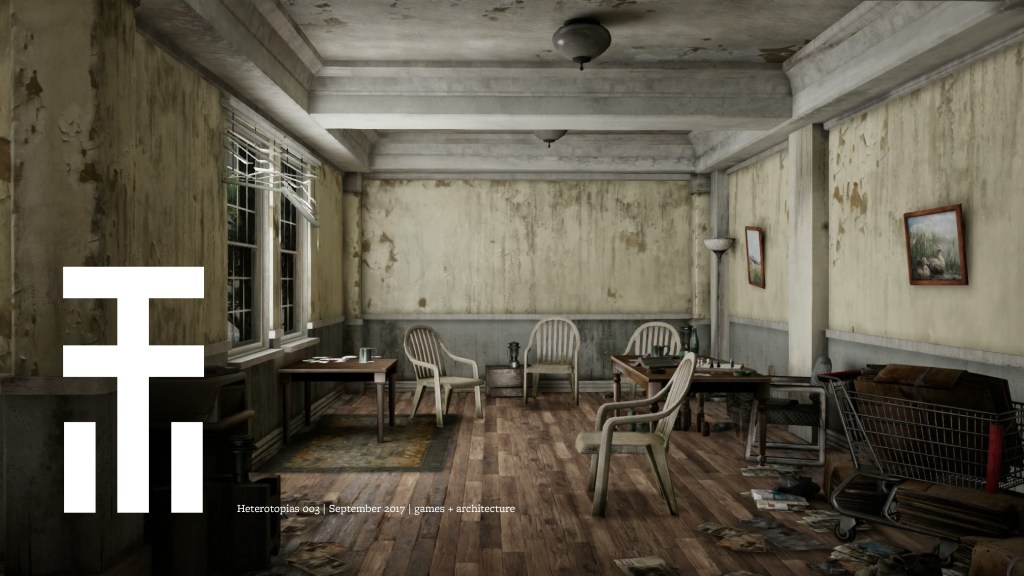Over the past few months, I’ve become increasingly aware of the fact that my attention span is shrinking. Twitter is the likely culprit: It’s the first thing I open in the morning. I check it regularly at work. It’s frequently the last app I use before going to bed. A likely side effect of scrolling through the gusher of hot takes is a slow inoculation against sustained thought.
In sum: My protozoan brain is being fried in the microwave of Twitter.
Videos by VICE
Heterotopias, a digital zine about architecture and culture in virtual spaces, feels like an antidote to that modern anxiety. Its essays benefit from multiple, careful readings, and sing when given the chance to mingle with other ideas and other media. Only three issues have been released so far, each roughly three months apart, so the zine is—mercifully—a refuge from the news cycle. Most importantly, though, Heterotopias is animated by a sense of slow-burning anarchic experimentation that feels in short supply in the churn of constant media production.
(Disclosure: Waypoint previously published an excerpt of an essay, “Bathrooms Without Bodies,” which was featured in Heterotopias 003.)
This descent into anarchy begins with the demolition—or at least a deep academic probing—of the fiction of the game world. “We are very familiar with the idea of reading games as worlds,” says Gareth Damian Martin, the founding editor of Heterotopias. “We generally consider them as all encompassing spaces with laws and systems, histories and characters, narratives and mechanics. But in many ways, considering games only in this way limits our view and also allows the game and its makers to dictate the terms of our discussion.”

Moving past this opens games to new forms of exploration and play—as well as new dimensions of criticism, says Martin. “It puts games on the same spectrum as all man made objects, art and culture, allowing for a deeper criticism of their fictions and forms.” This idea is exhilarating.
I started reading Heterotopias while on vacation at a water park with some friends. One of our favorite places at the park was a lazy river that looped around the entire complex. My friends and I frequently attempted to stop and push back against the current. Inevitably, the water (or a critical mass of people and pool rings) would push us forward, or a lifeguard would amble over to tell us to stop. And still we dug in our heels, time and again—not for any particular reason, but just for the strange satisfaction of stepping out of the rule-set and creating our own, makeshift fun.
Heterotopias is an exploration of that impulse in virtual space—where consequences and limitations are fewer, and rules can be stretched. At one point in our conversation, Martin brings up a video I had never seen before—a perfectly-unexplainable flavor-of-the-internet oddity. In slanted camcorder video footage, someone is playing Call of Duty on their TV. The player character stands in front of a door. His AI teammates are ready to breach. One barks: “shoot the hinges!”
The player aims down his sights at the hinges. But instead of shooting, they turn around and walk away from the door. They spend the next five minutes wandering around the map.
“His teammates are shouting ‘shoot the hinges!’ and he just goes and wanders off around the map—I find that amazing,” says Martin. “That’s something in Heterotopias’ space. We take this moment of urgency and then we explode it into a moment of wandering and emptiness and suddenly that space becomes totally changed.”
Heterotopias gladly shrugs off the lifeguards and the scoldings. It’s a relief from those factions of the discourse that demand fealty to bland literalism, the belief that there is a correct way for games to be played or understood. The fact that the zine is sustainable and pays its writers is a sign that there’s an appetite for broken rules and new forms of play.
If the moral arc of the universe bends toward justice, its curvature is particularly hard to discern these days.
This idea is most explicitly expressed in Robert Yang’s standout essay, “Consider the Chair,” for Heterotopias 002. For much of the piece, Yang covers the signals sent by certain types of chairs in games: the cheap white plastic Grosfillex chair is “trashy,” and signals “poverty and despair”; Dr. Breen’s tall, leather office chair in Half-Life 2 is “unique and one-of-a-kind,” and signifies Breen’s high status.
The essay takes a forceful turn toward the end. Games’ reliance on existing signifiers represents a “profound failure of imagination in games.” Why tether games to symbols that mirror real life? “Let us make games to dance with chairs, but also sing with dirt and nap with volcanos— and maybe one day, just maybe, that visionary game will let us cry for the chair too,” writes Yang.
There’s something vaguely utopian to this idea. If the moral arc of the universe bends toward justice, its curvature is particularly hard to discern these days. Many of the symbols and connections and ideas and rules we’ve inherited have been upturned, and their rot exposed. In virtual spaces, finally, there is refuge, and a freedom to create new symbols, new histories, and new fictions.
More
From VICE
-

AEW -

(Photo by Massimo Borchi/Atlantide Phototravel / Getty Images) -

Screenshot: Hopoo Games -

Collage by VICE
